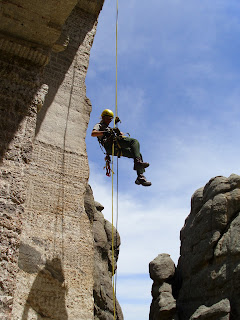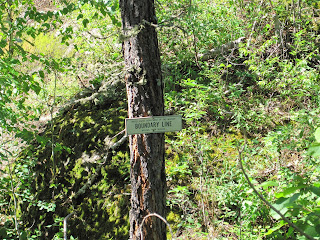 My fourth week here at Mount Rushmore has been both informative and interesting. I started the week with the Ropes Team assisting them in the Rock Monitoring project. Unfortunately it was extremely windy while being on the mountain. This prevented the rangers from being able to rappel down the faces to attach the proper fiber cables. Instead, we put out the climbing rope they would be using and practiced fusing the fiber together. I was still suited up in the climbing harness so LE Chief Don Hart said we could do a quick training lesson in climbing. We did so right outside the entrance to the Hall of Records which most people cannot say they have done!
My fourth week here at Mount Rushmore has been both informative and interesting. I started the week with the Ropes Team assisting them in the Rock Monitoring project. Unfortunately it was extremely windy while being on the mountain. This prevented the rangers from being able to rappel down the faces to attach the proper fiber cables. Instead, we put out the climbing rope they would be using and practiced fusing the fiber together. I was still suited up in the climbing harness so LE Chief Don Hart said we could do a quick training lesson in climbing. We did so right outside the entrance to the Hall of Records which most people cannot say they have done!
The climbing equipment that they use is top of the line and a lot different from the types we have used for rappelling at Leadership Camp. Their gear is designed for when you are free hanging and unable to climb up actual rock; for example when they are going over the face of Lincoln they are simply free hanging in front of his face. The gear that I was being taught with consisted of an ascender with a hand grip, descender, a foot strap, and a shunt. To climb up, you typically use the ascender with the hand grip and foot strap and to lower yourself back down you can use the descender. However, both devices can be interchangeable and can do both functions. The shunt is used as a safety device to ensure that you always have two points of contact on the rope to prevent you from any falling accident. To climb up, you slide the ascender up the rope and while holding onto the hand grip you essentially “stand” in the foot strap. You continue with this mechanism until you reach the desired height. To come back down, you have to switch out the ascender with the descender; this can be pretty tricky the first couple times you try it. After doing this a few times I was finally able to get the hang of it. Once the descender is attached properly you pull down on the rope lock and slowly lower yourself down. It was so great to see and use a climbing technique that I was not familiar with and I am greatly looking forward to the next time I am able to climb!
 |
| Using the ascender to climb up the rope. |
 |
| Switching out the ascender and descender. |
 |
| Lowering myself using the descender. |
This past week I also got the opportunity to attend the Wildland Fire Chain Saws class with LE Ranger Joe Turgyan. The class consisted of completing four powerpoint modules that went over safety requirements, chain saw maintenance and operation, chain saw tasks and techniques, and fireline construction and mopup. We learned about the proper PPE that should be worn at all times and the duties of sawyers (those working the chain saw) and swampers (those looking out for possible hazards and cleaning brush cut by the sawyer). Safety is the most important thing when handling a chain saw and they made sure to emphasize the fact that if you are not comfortable with cutting down a certain tree then don’t do it. We were also taught the various things to look out for when operating a chain saw. Depending on whether you are cutting the top or bottom side of a log there will be a push or pull on the chain saw. This means that depending on the angle, the chain saw may pull you towards the log being cut or push you away from it. They also told us to be very careful when using the very end of the chain saw for cutting because it will have a kickback affect that will kick the chain saw back towards your body (usually the head). Once we complete the field day portion of the training, I will be certified to cut trees of eight DBH (diameter breast height) or less while working a wildland fire.
 |
| One of the NPS boundary signs. |
The week ended with a great morning hike in the back country of the park. Another ranger Laura Mischell and I hiked the perimeter of the park along the boundary of the Forest Service. We were following the NPS boundary signs which get difficult in some spots. Due to the lay of the land there will be a marker on one side of a large boulder that you then have to climb over to find the other one, which isn’t always very visible. We also brought a digital GPS along with us to assist in our navigating abilities. The GPS is very helpful in getting acclimated with sense of direction which can be quite confusing in the woods.
This has been another great week in the Black Hills; I hope everyone is continuing to enjoy themselves at their various parks!
ProRanger Erin Langeheine



No comments:
Post a Comment